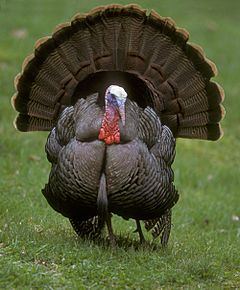Wild turkey facts for kids
The wild turkey (Meleagris gallopavo) is a large and well-known bird. It is one of two types of turkeys found in the world. You can find these amazing birds living in many parts of the United States and southern Canada.
Wild turkeys are the original birds from which the turkeys we eat on holidays were tamed and bred. People started raising them on farms a long time ago.
Quick facts for kids Wild turkey |
|
|---|---|
 |
|
| Male (Tom) wild turkey displaying | |
| Scientific classification | |
| Kingdom: | |
| Class: | |
| Order: | |
| Family: | |
| Genus: | |
| Binomial name | |
| Meleagris gallopavo |
|
Contents
Where Wild Turkeys Live
Wild turkeys love to live in forests. They especially like forests with hardwood trees like oaks and maples. They also enjoy mixed forests that have both hardwood and conifer (evergreen) trees.
These birds need open spaces too. They often look for areas like pastures, fields, orchards, and even seasonal marshes. These open spots help them find food and move around easily.
Wild turkeys are very good at adapting to different places. As long as there is good cover for safety and open areas to fly, they can make it their home. The best places for them are usually older forests with many different kinds of trees.
Wild vs. Domesticated Turkeys
The wild turkey is the ancestor of the turkeys we see on farms. People started to tame wild turkeys many centuries ago. They then bred them to be larger and easier to raise for food.
Wild turkeys are much more athletic than their farm relatives. They can fly quickly for short distances. They also run very fast and are excellent at hiding in the forest. Farm turkeys, on the other hand, usually cannot fly and are much heavier.
What Wild Turkeys Eat
Wild turkeys are omnivores. This means they eat both plants and small animals. Their diet changes with the seasons. They spend a lot of time on the ground looking for food.
In the fall and winter, they mostly eat nuts like acorns and seeds. They also look for berries and roots. In the spring and summer, they add more insects to their diet. They might eat grasshoppers, beetles, and even small lizards or frogs.
Wild Turkey Life Cycle
Wild turkeys have an interesting life cycle. Male turkeys are called toms or gobblers. Female turkeys are called hens. Young turkeys are called poults.
Reproduction
In the spring, toms try to attract hens. They do this by fanning out their tail feathers and making loud "gobble" sounds. This display is very impressive to watch. Hens will choose a tom to mate with.
After mating, the hen builds a nest on the ground. She usually hides it well under bushes or in tall grass. A nest can have anywhere from 4 to 17 eggs, but usually around 10 to 12. The eggs are a creamy color with reddish-brown spots.
Raising Poults
The hen sits on her eggs for about 28 days until they hatch. Once the poults hatch, they are very small and fluffy. They can walk and follow their mother almost immediately. The hen takes care of her poults, teaching them how to find food and stay safe from predators.
Poults grow quickly. They learn to fly when they are a few weeks old. They stay with their mother for several months, often until the fall. Young turkeys then start to become more independent.
Images for kids
-
Female wild turkey with young, from Birds of America by John James Audubon
See also
 In Spanish: Pavo salvaje o guajolote para niños
In Spanish: Pavo salvaje o guajolote para niños












